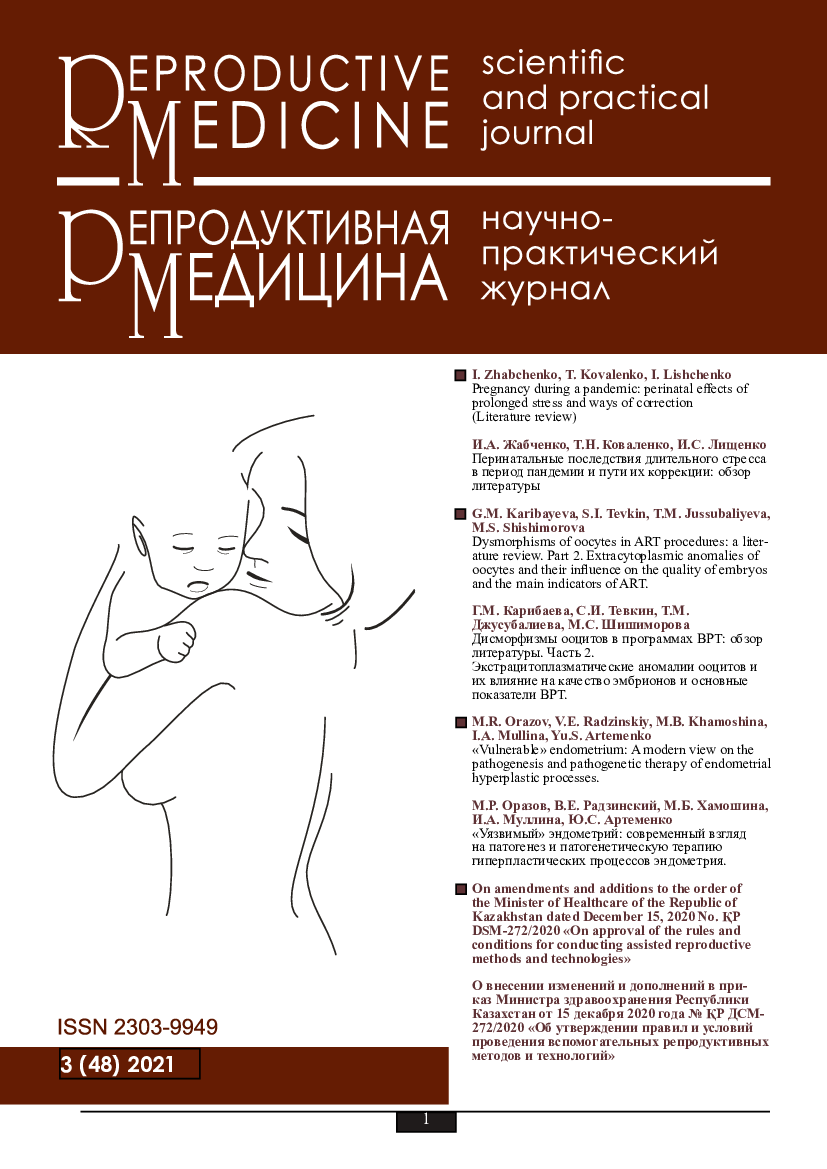"Vulnerable" endometrium: A modern view on the pathogenesis and pathogenetic therapy of endometrial hyperplastic processes
DOI:
https://doi.org/10.37800/RM.3.2021.54-60Keywords:
endometrial hyperplasia, atypical hyperplasia, endometrial cancer, progestins, hysterectomyAbstract
Relevance: Endometrium is a unique human tissue with a strong regenerative potential implemented after desquamation during each menstrual cycle. At that, regeneration in the endometrium is not accompanied by scarring. Endometrial hyperplasia as a variant of defect transformation is a widespread disease that remains an urgent problem of modern medicine. In recent years, endometrial hyperplasia is becoming more common among patients of reproductive age. This problem is even more significant due to the spread of endometrial cancer in developed countries and endometrial hyperplasia being its precursor.
Purpose: The article describes modern views on the pathogenesis and pathogenetic therapy of endometrial hyperplastic processes.
Materials and Methods: Sources available in the Pubmed, Embase, Cochrane databases were analyzed, and international reviews of randomized controlled studies in that area were selected for the recent years using the keywords "endometrial hyperplasia," "atypical hyperplasia," "endometrial cancer," "progestins," and "hysterectomy."
Results: The article discusses the modern ideas about etiology, pathogenesis, and the tactics of management of patients according to the data of Russian and world literature.
Conclusion: Despite the centuries-old study of endometrial hyperplasia, its pathogenetic mechanisms remain rather undisclosed. The factors associated with the recurrent course of the disease remain unexplored. Choosing the tactics of managing patients suffering from endometrial hyperplasia is still a question to be solved.
References
Оразов М.Р. Акушерство и гинекология: новости, мнения, обучение, 2016; 3: 46-58 [Orazov M.R. Akusherstvo i ginekologiya: novosti, mneniya, obuchenie, 2016; 3: 46-58];
Оразов М.Р., Радзинский В.Е., Аракелов С.Э., Хамошина М.Б., Носенко Е.Н., Духин А.О., Токтар Л.Р., Читанава Ю.С., Орехов Р.Е., Абитова М.З. Трудный пациент, 2019; 17(5): 19-21 [Orazov M.R., Radzinskij V.E., Arakelov S.E'., Xamoshina M.B., Nosenko E.N., Duxin A.O., Toktar L.R., Chitanava Yu.S., Orexov R.E., Abitova M.Z. Trudnyj pacient, 2019; 17(5): 19-21];
Siegel R.L., Miller K.D., Jemal A. CA Cancer J Clin., 2018; 68(1): 7-30. https://doi.org/10.3322/caac.21442;
Каприн А.Д., Старинский В.В., Шахзодова А.О. Злокачественные новообразования в России в 2019 году (заболеваемость и смертность). – МНИОИ им. П.А. Герцена − филиал ФГБУ «НМИЦ радиологии» Минздрава России, 2020. − илл. − 252 с. [Kaprin A.D., Starinskij V.V., Shaxzodova A.O. Zlokachestvennye novoobrazovaniya v Rossii v 2019 godu (zabolevaemost' i smertnost'). – MNIOI im. P.A. Gercena − filial FGBU «NMIC radiologii» Minzdrava Rossii, 2020. − ill. − 252 s.];
Iversen M.L., Dueholm M. Eur. J. Obstet. Gynecol. Reprod. Biol. 2018; 222: 171-175. https://doi.org/10.1016/j.ejogrb.2018.01.026;
Думановская М.Р., Чернуха Г.Е., Асатурова А.В., Коган Е.А. Акушерство и гинекология, 2015; 3: 40-44 [Dumanovskaya M.R., Chernuxa G.E., Asaturova A.V., Kogan E.A. Akusherstvo i ginekologiya, 2015; 3: 40-44];
Hannemann M.M., Alexander H.M., Cope N.J. Obstet. Gynecol. Reprod. Med., 2010; 20(4): 116-120;
Auclair M.H., Yong P.J., Salvador S., Thurston J., Colgan T.T.J., Sebastianelli A. J. Obstet. Gynaecol. Can. 2019; 41(12): 1789-1800. https://doi.org/10.1016/j.jogc.2019.03.025;
Erdem B., Aşıcıoğlu O., Seyhan N.A., Peker N., Ülker V., Akbayır Ö. Int. J. Surg., 2018; 53: 350-3. https://dx.doi.org/10.1016/j.ijsu.2018.04.019;
BSGE, Royal College of Obstetricians & Gynaecologists. Management of Endometrial Hyperplasia. Green-top Guideline No. 67, RCOG/BSGE Joint Guideline, 2016. https://www.rcog.org.uk/globalassets/documents/guidelines/green-top-guidelines/gtg_67_endometrial_hyperplasia.pdf;
Trimble C.L., Method M., Leitao M., Lu K., Ioffe O., Hampton M., Higgins R., Zaino R., Mutter G.L. Obstet. Gynecol., 2012; 120: 1160–1175;
Song D., Feng X., Zhang Q., Xia E., Xiao Y., Xie W. et al. Reprod. Biomed. Online, 2018; 36(1): 78-83. https://dx.doi.org/10.1016/j.rbmo.2017.09.008;
Sanderson P.A., Critchley H.O.D., Williams A.R.W., Arends M.J., Saunders P.T.K. Hum. Reprod. Update, 2017; 23(2): 232-54. https://dx.doi.org/10.1093/humupd/dmw042;
Suidan R.S., He W., Sun C.C., Zhao H., Fleming N.D., Ramirez P. et al. Gynecol. Oncol. 2017; 145(1): 55-60. https://dx.doi.org/10.1016/j.ygyno.2017.01.025;
Mitsuhashi A., Uehara T., Hanawa S., Shozu M. Support Care Cancer, 2017; 25(5): 1495-501. https://dx.doi.org/10.1007/s00520-016-3554-y;
Wartko P.D., Beck T.L., Reed S.D., Mueller B.A., Hawes S.E. Cancer Causes Control, 2017; 28(8): 819-28. https://dx.doi.org/10.1007/s10552-017-0908-9;
Chandra V., Kim J.J., Benbrook DM, et al. J. Gynecol. Oncol., 2016; 27: e8. https://doi.org/10.3802/jgo.2016.27.e8;
Emons G., Beckmann M.W., Schmidt D. et al. Geburtshilfe Frauenheilkd, 2015; 75: 135–136. https://dx.doi.org/10.1055%2Fs-0034-1396256;
Wheeler D.T., Bristow R.E., Kurman R.J. Am. J. Surg. Pathol., 2007; 31: 988-998;
Dijkhuizen F.P., Mol B.W., Brolmann H.A. et al. Cancer, 2000; 89: 1765-1772;
Singh G., Puckett Y. Endometrial Hyperplasia. [Updated 2021 Jul 26]. In: StatPearls [Internet]. Treasure Island (FL): StatPearls Publishing; 2021 Jan-. https://www.ncbi.nlm.nih.gov/books/NBK560693/;
Lacey J.V. Jr, Sherman M.E., Rush B.B. et al. J. Clin. Oncol., 2010; 28: 788-792;
Reed S.D., Newton K.M., Clinton W.L., Epplein M., Garcia R., Allison K. et al. Am. J. Obstet. Gynecol. 2009; 200: 678.e1-6. https://doi.org/10.1016/j.ajog.2009.02.032;
Гинекология. Национальное руководство / под ред. Г.М. Савельевой, Г.Т. Сухих, В.Н. Серова, В.Е. Радзинского, И.Б. Манухина. 2020г. – 1008 с. [Ginekologiya. Nacional'noe rukovodstvo / pod red. G.M. Savel'evoj, G.T. Suxix, V.N. Serova, V.E. Radzinskogo, I.B. Manuxina. 2020g. – 1008 s.];
Nooh A.M., Abdeldayem H.M., Girbash E.F., Arafa E.M., Atwa K., Abdel-Raouf S.M. Reprod. Sci., 2016; 23: 448-454. https://doi.org/10.1177/1933719115623643;
Moradan S., Nikkhah N., Mirmohammadkhanai M. Adv Ther., 2017; 34: 1211–1220;
Moore E., Shafi M. Obstet. Gynaecol. Reprod. Med., 2013; 23: 88-93. https://doi.org/10.1016/j.ogrm.2013.01.002;
Beavis A.L., Cheema S., Holschneider C.H., Duffy EL, Amneus MW. Gynecol. Oncol. Rep., 2015; 13: 71-75. https://www.ncbi.nlm.nih.gov/pmc/articles/PMC4563798/;
Concin N., Matias-Guiu X., Vergote I., Cibula D. et al. Radiother. Oncol., 2021; 154: 327-353. https://doi.org/10.1016/j.radonc.2020.11.018;
Gallos I.D., Yap J., Rajkhowa M. et al. Am. J. Obstet. Gynecol., 2012; 207: 266.e1-12. https://doi.org/10.1016/j.ajog.2012.08.011;
Simpson A.N., Feigenberg T., Clarke B.A. et al. Gynecol. Oncol., 2014; 133: 229-233.
Ørbo A., Arnes M., Vereide A.B. et al. BJOG, 2016; 123(9): 1512-1519. https://dx.doi.org/10.1111%2F1471-0528.13763;
Park J.Y., Lee S.H., Seong S.J. et al. Gynecol. Oncol., 2013; 129(1): 7-11. https://doi.org/10.1016/j.ygyno.2012.12.037;
Gressel G.M., Parkash V., Pal L. Int. J. Gynaecol. Obstet., 2015; 131: 234-239. https://doi.org/10.1016/j.ijgo.2015.06.031.
Additional Files
Published
How to Cite
Issue
Section
License
The articles published in this Journal are licensed under the CC BY-NC-ND 4.0 (Creative Commons Attribution – Non-Commercial – No Derivatives 4.0 International) license, which provides for their non-commercial use only. Under this license, users have the right to copy and distribute the material in copyright but are not permitted to modify or use it for commercial purposes. Full details on the licensing are available at https://creativecommons.org/licenses/by-nc-nd/4.0/.




